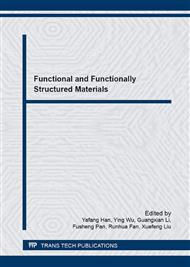p.618
p.624
p.633
p.645
p.652
p.657
p.664
p.669
p.675
Preparation and Characterization of Amorphous Fe-B-P Ultrafine Particles
Abstract:
Soft magnetic Fe-B-P ultrafine particles with amorphous structure were prepared by aqueous reduction method with variable pH values. The microstructure, compositions and the soft magnetic properties of Fe-B-P submicron particles were investigated by using field emission scanning electron microscope (FE-SEM), X-Ray Diffraction (XRD), mössbauer spectrum (MS), inductively coupled plasma atomic emission spectroscopy (ICP-AES), vibrating sample magnetometer (VSM). The results showed that a series of Fe-B-P amorphous particles with the average particle size of 0.26~0.42 μm were obtained depending on the pH value of solution. As pH value increased, the contents of B and P increased, and the specific saturation magnetization of the Fe-B-P submicron particles decreased. Some electrons, transferred from p-shell of B atoms and P atoms to 3d-shell of Fe atom, resulted in the decrease of the number of unpaired electron, which in turn led to reduction of the average hyperfine magnetic field of the Fe-B-P particles and the decrease of the magnetic torque of Fe atoms. The relation between hyperfine magnetic field (Hhf) and the specific saturation magnetization was in accord with the Marshall’s equation. At the same time, the enhancement of the shielding effect on 4s electron orbital, i.e., the density of 4s electron reduced, leading to the increase of Isomer Shift.
Info:
Periodical:
Pages:
652-656
Citation:
Online since:
March 2016
Authors:
Price:
Сopyright:
© 2016 Trans Tech Publications Ltd. All Rights Reserved
Share:
Citation:


